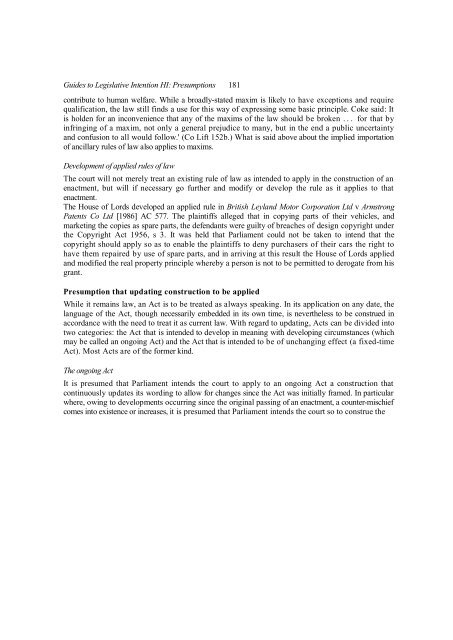Statutory Interpretation The Technique of Statutory ... - Francis Bennion
Statutory Interpretation The Technique of Statutory ... - Francis Bennion
Statutory Interpretation The Technique of Statutory ... - Francis Bennion
Create successful ePaper yourself
Turn your PDF publications into a flip-book with our unique Google optimized e-Paper software.
Guides to Legislative Intention HI: Presumptions 181<br />
contribute to human welfare. While a broadly-stated maxim is likely to have exceptions and require<br />
qualification, the law still finds a use for this way <strong>of</strong> expressing some basic principle. Coke said: It<br />
is holden for an inconvenience that any <strong>of</strong> the maxims <strong>of</strong> the law should be broken ... for that by<br />
infringing <strong>of</strong> a maxim, not only a general prejudice to many, but in the end a public uncertainty<br />
and confusion to all would follow.' (Co Lift 152b.) What is said above about the implied importation<br />
<strong>of</strong> ancillary rules <strong>of</strong> law also applies to maxims.<br />
Development <strong>of</strong> applied rules <strong>of</strong> law<br />
<strong>The</strong> court will not merely treat an existing rule <strong>of</strong> law as intended to apply in the construction <strong>of</strong> an<br />
enactment, but will if necessary go further and modify or develop the rule as it applies to that<br />
enactment.<br />
<strong>The</strong> House <strong>of</strong> Lords developed an applied rule in British Leyland Motor Corporation Ltd v Armstrong<br />
Patents Co Ltd [1986] AC 577. <strong>The</strong> plaintiffs alleged that in copying parts <strong>of</strong> their vehicles, and<br />
marketing the copies as spare parts, the defendants were guilty <strong>of</strong> breaches <strong>of</strong> design copyright under<br />
the Copyright Act 1956, s 3. It was held that Parliament could not be taken to intend that the<br />
copyright should apply so as to enable the plaintiffs to deny purchasers <strong>of</strong> their cars the right to<br />
have them repaired by use <strong>of</strong> spare parts, and in arriving at this result the House <strong>of</strong> Lords applied<br />
and modified the real property principle whereby a person is not to be permitted to derogate from his<br />
grant.<br />
Presumption that updating construction to be applied<br />
While it remains law, an Act is to be treated as always speaking. In its application on any date, the<br />
language <strong>of</strong> the Act, though necessarily embedded in its own time, is nevertheless to be construed in<br />
accordance with the need to treat it as current law. With regard to updating, Acts can be divided into<br />
two categories: the Act that is intended to develop in meaning with developing circumstances (which<br />
may be called an ongoing Act) and the Act that is intended to be <strong>of</strong> unchanging effect (a fixed-time<br />
Act). Most Acts are <strong>of</strong> the former kind.<br />
<strong>The</strong> ongoing Act<br />
It is presumed that Parliament intends the court to apply to an ongoing Act a construction that<br />
continuously updates its wording to allow for changes since the Act was initially framed. In particular<br />
where, owing to developments occurring since the original passing <strong>of</strong> an enactment, a counter-mischief<br />
comes into existence or increases, it is presumed that Parliament intends the court so to construe the

















